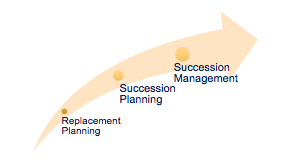The Succession Management Continuum: Where is Your Law Firm?
 Recent surveys show that less than a third of law firms have a formal retirement or succession planning process in place. Those that have one tend to focus more on retirement age and phase-down compensation approaches usually with a focus only on a few partners expected to retire within two to five years. A much better approach would be to address retirement and succession as part of a talent life cyclenot a one-time event.
Recent surveys show that less than a third of law firms have a formal retirement or succession planning process in place. Those that have one tend to focus more on retirement age and phase-down compensation approaches usually with a focus only on a few partners expected to retire within two to five years. A much better approach would be to address retirement and succession as part of a talent life cyclenot a one-time event.
At present, many law firms approach succession the way they do other aspects of their business: on a reactive or ad hoc basis and with an internal focus that often leaves clients out of the conversation. Firms often do not have a strategic plan in place, much less succession and transition plans. As individual partners approach sixty or so, the managing partner might begin to have conversations about their plans for retirement. It is one partner at a time, and often, not systematic or structured, which often leads to misaligned expectations and friction. To the extent there are discussions about transitions, firms rarely involve clients in discussions and considerations about pending retirements. As the number of baby boomer partners move closer to retirement, firms without a more structured and transparent approach may find it difficult to hold on to clients, may lose the revenue associated with important clients tied to senior partners, and may lose the next generation of partners that are supposed to be successors but who become frustrated by the resistance senior partners have to transitioning clients.
It is time to better understand and approach succession as part of the firm’s ongoing growth and talent strategy. There are three stages on the succession planning continuum: replacement planning, succession planning and succession management. All three of these reflect different levels of talent management and all three represent more formal planning than most law firms do now.
 Replacement planning is the process by which the firm identifies the top two or three founders, leaders and/or rainmakers that the firm risks losing to pending retirements. Possible replacements for those individuals are identified but other than identifying individual replacements, nothing else is done.
Replacement planning is the process by which the firm identifies the top two or three founders, leaders and/or rainmakers that the firm risks losing to pending retirements. Possible replacements for those individuals are identified but other than identifying individual replacements, nothing else is done.
Succession planning is more systematic than replacement planning in that once individuals are identified as successors, there is some development, support and a transition planning that takes place from the individuals to the identified successors. It still, however, focuses only on the top positions and roles where imminent departures exist.
Succession management is the most robust and effective approach as it seeks to achieve talent continuity throughout the firm at multiple levels. It is more of a strategy that occurs throughout the talent life-cycle that considers the skills your firm needs now and in the future, core competencies needed for high performing professionals, the talent you currently have to fill important roles in management, leadership and rainmaking and the type of recruiting, professional development, and experiential support you are providing that talent. Embracing succession management helps protect firms from unexpected or unwanted departures or turnover, build stronger and broader talent pools to select from and creates a more nimble and stable organization.
If your goal is to build a resilient law firm that withstands the inevitable challenges of running a law firm today and that results in a legacy that can be passed down to the next generation, you will want to begin a more systematic and ongoing approach to succession management. The following is a framework for this process:
- Define leadership/client relationship/rainmaker roles and core competencies for each key partner role and management area
- Conduct a gap inventory of present and future skills, competency and role gaps
- Define your criteria for “high potentials,” whether that be as leaders, rainmakers or managers
- Review your current talent pipeline using something like the “Nine-Box” method
- Devise a strategy that incorporates recruiting, training and development, promotion, retention, and evaluation for filling key positions
- Provide leadership and other skills development and coaching
- Develop and implement succession/knowledge transfer plans for each person; build these into practice group and departmental plans
- Appoint new leaders and rainmaker successors, evaluate and support
For additional insights on succession, please read our previous articles: Succession Part 1: Holding onto Clients When Senior Rainmakers Retire, Succession Part 2: Transitioning to Tomorrow’s Leaders and Succession Planning: Why Your Firm Should Do It.

